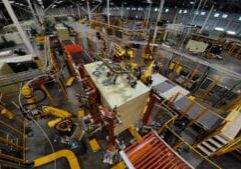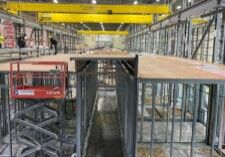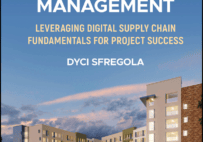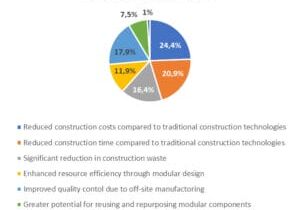Inflation Comes in Hot to Begin '24

Anirban Basu is the Chairman & CEO of Sage Policy Group and Chief Economist of the Modular Building Institute.
Last year was a shockingly good one for the U.S. economy, at least relative to expectations. Coming into 2023, the conventional wisdom was that near-term recession was inevitable in America. In the face of belligerent excess inflation (above the Federal Reserve’s 2 percent mandate), monetary policymakers began ratcheting interest rates higher in March 2022. That process continued throughout the balance of the year and into 2023. At least partially as a result, equity markets sustained large losses in 2022 as corporate borrowing costs soared.
All of this was viewed as precursors to a broader economic downturn. The high-powered economists at Bloomberg maintain a forecasting index that suggested that the probability of recession in America as of October 2022 was 100 percent.
Instead, America had a fine year economically even as Europe flirted with recession, Japan entered one, and as China languished. During 2023’s initial quarter, the U.S. economy expanded 2.2 percent on an annualized basis. The following quarter, growth ticked lower to 2.1 percent, suggesting to some that perhaps a recession was forthcoming during the back half of the year. Instead, the economy rallied, expanding at an unpredicted 4.9 percent during the third quarter and 3.4 percent during the fourth. For the year, the economy expanded 2.5 percent. If one compares the fourth quarter of 2022 to 2023’s fourth quarter, output grew an even more impressive 3.1 percent.

Anirban Basu speaks at the Modular Building Institute's annual World of Modular conference.
The outperformance of the economy coupled with breathless anticipation of Federal Reserve rate cuts pushed equity prices higher last year. The tech-laden Nasdaq expanded an eye-popping 43 percent, while the S&P 500 returned 24 percent and the Dow Jones 13 percent. Rate tightening ended with a quarter point rate increase on July 26th, 2023. Investors have been waiting for the renewal of monetary accommodation ever since. Alas, they may have longer to wait.
In June 2022, as supply chains struggled to normalize and as consumers were amid a spending spree, prices rose with especial rapidity in the context of widespread scarcity. During the one-year period ending June 2022, economy-wide inflation peaked at a 40-year high of 9.1 percent. But as supply chains improved thereafter and direct federal subsidies to households and businesses faded, inflation edged lower. By January 2024, year-over-year inflation was down to 3.1 percent according to the Consumer Price Index (CPI). If one engages in simple extrapolation, the Federal Reserve’s target rate of 2 percent must be right around the corner.
It is never so simple. The January data came in a bit hotter than expected. Many economists had predicted that the year-over-year inflation would have dipped below 3 percent. By March, overall inflation according to the CPI was back to 3.5 percent year-over-year. The core rate of inflation, which excludes food and energy prices, stood at 3.8 percent. Another measure, the core PCE deflator, a measured favored by Federal Reserve policymakers, was up 2.8 percent on a year-ago basis in February. In short, achievement of the 2 percent inflation target remains elusive.
Coming into the year, many investors anticipated in the range of six quarter-point rate cuts by the Federal Reserve. The first one was set to occur in March. That meeting has come and gone, and there has been no movement on rates.
In an April CNN article, Greg McBride, the chief financial analyst at Bankrate, said, “You can kiss a June interest rate cut goodbye.” The article also noted that the markets’ probability of a rate cut in June declined from 73 percent in March to just 21 percent as of April 10th, a reflection of the extent to which higher-than-expected inflation has surprised bond and other traders.
There are many implications, including the fact that mortgage rates are no longer declining. The result is that mortgage applications, a leading indicator of home sales, continue to be substantially below the 2021 cyclical peak. Nonetheless, home prices remain elevated since many homeowners have refinanced to ultra-low mortgage rates and choose not to sell the homes to which they are attached presently. Among those who suffer because of such dynamics are realtors (lack of transactional volume) and title agents (ditto).
The obvious question is why inflation is returning. As has been reported in recent months, wage pressures remain abundant; so much so that 2 percent inflation remains unlikely in the near-term. As of February, there were 8.8 million available, unfilled jobs in America. In March, the nation’s rate of unemployment fell to 3.8 percent. With so many job openings and so few people to fill them, wage pressures remain firmly in place.
But that is not where the causation story ends. A sea of newly emerging supply chain issues has emerged, including those involving Houthi rebels, Somali pirates, water levels in the Panama Canal, supply chain relocation, including from China to the U.S., Baltimore’s Francis Scott Key Bridge collapse and others. Each of these is conspiring to drive up costs, whether in the form of massive increases in maritime insurance or lengthier distances to travel.
As reported by Reuters (February 7th, London), certain underwriters have raised the premiums they charge to American, British, and Israeli firms by as much as 50 percent for ships transiting the Red Sea. As stated in a Reuters report from earlier this year, “This translates into hundreds of thousands of dollars of additional costs for a seven-day voyage.”
The Baltic Freight Index serves as a barometer for shipping costs by reflecting the price of transporting goods across the world. In 2020 and 2021, the index experienced substantial volatility. During peak recovery, the index rose more than 300 percent during a period of massive growth in the demand for goods and concomitant port congestion and container shortages. Prior to 2020, the average index value was in the range of 1,000, but that figure expanded to more than 4,000 by mid-2021. This is in fact the period during which inflation was at its most rampant, though the Federal Reserve did nothing to increase interest rates that year.
Since 2022, the index has trended downward as supply chains normalized or roughly so. Logistics improved and bottlenecks became less of an issue. By the end of 2023, the index had dipped in value to approximately 2,500. The decline reflected greater supply chain reliability, including the availability of diversified/alternative shipping routes and expanded investment in infrastructure. More recently, events both globally and domestically have restored volatility to the index.
More from Modular Advantage
Resia: Breaking All the Rules
Resia Manufacturing, a division of U.S.-based Resia, is now offering prefabricated bathroom and kitchen components to industry partners. Its hybrid fabrication facility produces more precise bathroom and kitchen components (modules) faster and at lower cost than traditional construction. Here’s how Resia Manufacturing does it.
How LINQ Modular Innovates to Bring Modular To The Market in the UAE and Beyond
LINQ Modular, with an office and three manufacturing facilities in Dubai, is a modular firm based in United Arab Emirates. The company is on a mission: to break open the housing and construction markets in the Gulf Cooperation Council (GCC) area with modular.
ModMax: Redefining Modular Construction with Confidence and Precision
ModMax was born out of frustration—frustration with five persistent pain points in modular construction: Permitting bottlenecks. Production delays. Rigid designs. Disconnect between “the office” and the field. Lack of transparency and communication.
LifeArk: Disaster-Resilient Housing from Recycled Plastic and 100-year-old Technology
Wee compares LifeArk’s housing units to Yeti coolers, as they are built similarly. Each component takes 15 to 20 minutes to manufacture, has an R-value of 40, and includes molded slots and chases for wiring, plumbing, fire sprinklers, and other utilities.
Building the Future of Modular Edge Infrastructure
The edge data center market is expanding rapidly, driven by the surge in AI workloads, IoT adoption, and the need for localized compute power. In these environments, sustainability, scalability, and reliability are non-negotiable. Cooling is among the most complex challenges for operators—and one of the most decisive factors in long-term success.
Accelerating Light-Gauge Steel Construction: A Semi-Automated Digital Workflow for Off-Site Projects
For construction professionals, the message is clear. By adopting semi-automation and digitalization, companies can deliver projects faster, more accurately, and more profitably, while also building stronger collaboration across teams. The approach is not about replacing people with machines, but about empowering people with better tools and processes.
Why Modular Data Centers Are Gaining Momentum
Artificial intelligence, high-performance computing, and edge applications push the limits of traditional “stick-built” data centers. They take years build, often struggle with high density workloads, and aren’t optimized for deployments near end users. Modular data center platforms are purpose-built to address these challenges, offering flexibility and scalability to adapt to evolving technologies, while opening new opportunities for the modular construction industry.
Supply Chain Innovation in Action: 5 Habits Every Modular Leader Should Practice
By applying these principles to supply chain practices — collaborative planning, strategic procurement, scenario modeling, digital tools, and transparent forecasting — construction leaders can build value chains that are not just efficient and agile, but truly innovative.
Exploring the Role of Modular Integrated Construction (MiC) in Advancing Circular City Principles – A Survey of Stakeholder Perspectives
The survey findings highlight the significant potential of Modular integrated Construction (MiC) in advancing the development of circular cities. By reducing costs, accelerating construction timelines, and minimizing waste generation, MiC offers a promising approach to sustainable urban development.
The Use of MS POLYMER™-Based Sealants and Adhesives in Modular Building
These products combine flexibility and elastic recovery with excellent adhesion to different substrates and have already shown their usefulness in traditional construction. Now it’s time for them to be put to use in the modular construction industry.










